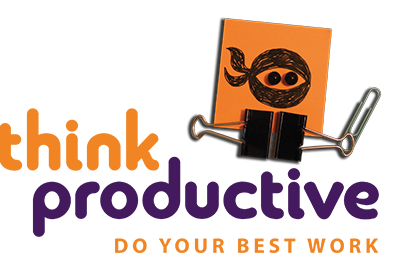I’m often asked about the best practices for managing your email inbox with the help of an assistant, and how that differs from managing your inbox ‘solo’ like in the email chapter of ‘How to be a Productivity Ninja’, or in our email training workshops. It’s something I’ve thought about a lot over the years. For many years I was actually quite reluctant to give up full control of my emails. I still think the idea of completely delegating or removing email from your life is unrealistic for most folks. Basically, only people with really dull jobs and lives can fully automate email! A great assistant can help you think and even pre-empt what you’re going to think about lots of things, but there will always be interesting things you’ll need to cast your eye on, where only you can know what you want to do next.
My assistant, Caitlin, has been with me for six months. Before that, I mainly used virtual assistants for email and diary management. This worked well, and everything I talk about here can be done virtually too, but sometimes there’s no substitute for being in the same room. It’s all about clear rules and clear communication. So here’s our basic approach.
Going Dark
The ultimate aim of having Caitlin manage my inbox and diary is to help me spend a lot of my time in ‘go dark’ mode. In other words, by her keeping an eye on things and processing as much as she can without me, I can not only switch email off, but – and here’s the crucial bit – trust that things are continuing in my absence and that I’m not going to miss anything big. So Caitlin’s main roles are:
- To filter out the stuff that needs my action into a separate folder.
- To handle diary enquiries, do the ‘nuts and bolts’ of setting up meetings, and handle the logistics of them such as travel.
- To help me with replies to emails when I’m processing (we do this by me dictating emails to her, which she sends out from my email address).
- To be a bit of a ‘gatekeeper’ for me. I get a lot of requests from people offering to buy me coffee in exchange for an hour of my time, and without Caitlin, I’d probably say yes to a lot more of them than is healthy or productive, just because I don’t like saying no! Having Caitlin in my corner here helps me evaluate what’s worthwhile, and also protect my own time for writing and creation.
- Caitlin also plays an important role as a bit of a sounding board for me – so sometimes I can talk through what I plan to say in response to a certain email, but the act of dictating it out loud makes me think twice, or change my mind, or just refine my approach.

Caitlin and I do Monday afternoons and Thursday mornings. For most people (including me, probably!), it would probably make more sense to do it daily or more than twice a week.
The key folders we use as part of my inbox management…
@Graham2Read
This folder is where Caitlin puts the stuff I should read. The idea is to cut out the strings of emails, the unnecessary stuff, the ‘thanks’ replies, etc, before I get to it. So when I get to this folder with her, it’s kind of like the inbox, (but quicker for me to deal with).
@circulars
To make the above work, the circulars folder also acts as a catch-all for any “if in doubt” emails that Caitlin isn’t confident about deleting. The deal is I should check that folder once a week or so.
@diary
Anything to do with dates or my availability goes in here. Then, twice a week when we process the inbox, and once ‘g2r’ has been cleared down to zero together, we also throw out the diary requests, look at what I can say yes to, and work out how to make my travel as efficient as possible. Basically I find this 10 times easier when I can properly get deep into the calendar, and make less mistakes/double bookings that way.
Some others that either I’ve played with, or coached others to use…
@Tomtoaction
Worked with an MP and his assistant. She put stuff in there that definitely needed his email reply as the next move.
@standardaction
Same MP would use this folder for things like stock replies to petition letters, where basically the action is so self-explanatory that it doesn’t need discussing.
@financeactions
When I did all the finance and book-keeping for the company for a while, I used this to batch process it, much like the @diary folder.

Talk about the fuck-ups, without swearing
Finally, the other piece of advice I would give about making it work is to do a 5 minute “how’s it going” review of your communication once a week (in addition to longer 121’s about the job in general, of course). Caitlin has a really hard job, which is to second-guess how I would think, and pre-empt what I need. So it’s easy for frustration to build up on both sides when communication is less than crystal clear. Create a checklist to ask the questions here, including “what’s bugged me this week” so that you make it explicitly OK to have the awkward conversations. And realize it’s about continuously improving it, rather than getting perfect about it. It’s too stressful a thing to expect to be done perfectly – but that’s easy to forget that in the day-to-day. If you both treat occasional mistakes as just a natural part of the process, rather than a crisis to feel angry or guilty about, then it makes the entire thing much easier.
By Graham Allcott
